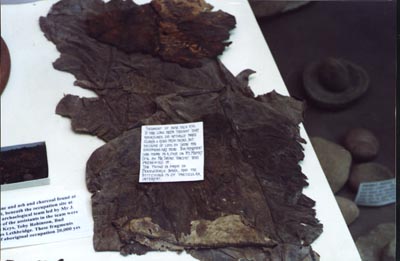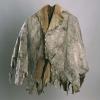Quilt No.956BF - Miles Pioneer Village

Owner:
Miles Pioneer Village
Location:
QLD South West
Maker
Maker:
Unknown
Made in
AUSTRALIA QLD
Patterms
Date:
Unknown
Description:
3 fragments of koala bear skin joined with very fine stitching. Uneven edges. Thought to have been part of an aboriginal cloak or rug.
History:
Given to Bud Ford about 1960 by the then owner of Mt. Moffat station, an old established pastoral holding in the area north of Mitchell, Queensland. It is on permanent loan to the Miles Pioneer Village and Museum at Miles south west Queensland.
Story:
The stations in the area this piece came from were known to have considerable aboriginal labour, the men in the mustering camp and the women as domestic labour. It was found in a cave. Bud Ford remarked that the stitching was definitely not done the traditional way with a bone awl and whilst the thread hasn't been analysed he thought it wasn't hair or bark and could have been linen thread.
Related Quilts:
Kangaroo skin cloak of seven gores is made from the skins of seven grey kangaroos (Macropus fuliginosus). The skins vary in size and shape, the inner five are roughly triangular. The cloak is edged with a series of loops, through one of these near the collar is a piece of cloth which appears to have tied the cloak together. The skins are sewn together with two sorts of linen or cotton thread. In a small diamond-shaped gusset at the back of the neck there are some stitches of sinew. The skins are sewn together by means of a small hem which was turned back on to the fur, so stitches went through two layers of skin on each gore. There are some small holes in the skins. The skins are very soft and pliable, and greyish in colour; they vary in size and shape.
Longest part: 800mm
Ref: MA Thesis 1973, S.Meagher 'A Reconstruction of the Traditional Life of the Aborigines of the S.W. of Western Australia.
Rug made from 54 Platypus skins; 6 rows of 9 rectangular pelts, brown with creamy yellow edges, machined together. The backing is red felt or baize and extends beyond the top with a punched scalloped border. The backing is hand stitched to the top and has a centre motif of a flower outlined in black braid within a large black rectangle.
1890 x 1635mm
Possum skin cloak. Possum skins sewn together with vegetable fibre or kangaroo sinew. Designs incised into the skins, some of which are decorated with ochres.
2070 x 1540mm
Platypus skin rug. Skins are joined in 7 rows with the larger skins on the outside and the smaller ones in the centre. Skins are rich dark brown with yellow/cream sides (the belly fur). The backing is dark brown felt extending beyond the fur and with a stamped scalloped edge.
1720 x 1490mm
Rug made from skins of black quolls. The skins are dark grey-brown with black areas and each skin has cream spots. The skins are mainly machine stitched together with a few roughly hand sewn. The backing is maroon felt and this extends beyond the top with a scalloped edging. There is yellow ric-rac braid hand sewn on the back seam.
1300 x 885mm
Fox skin rug of exceptionally fine skins with brushes incorporated into the design. It is backed with brown felt with traditional stamped scalloped edge. 1800 x 1500mm






